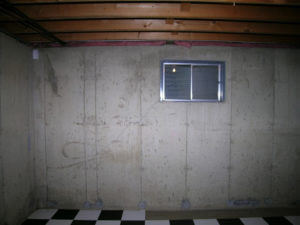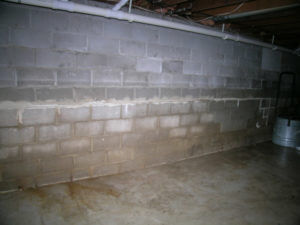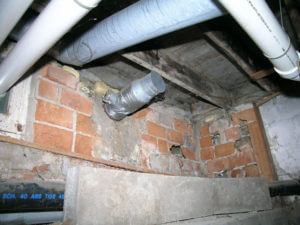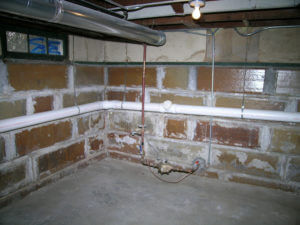Common Foundation Construction Types
There are many types of foundation construction which have been used over the last 150 years in this area of the country. Some of the most common foundation types include:

Cast in Place Concrete
Our experience is that cast in place concrete has been used for foundation walls in this area of the country since around the 1920’s. It is generally a very durable material which can be formed and cast into almost any configuration. It’s ability to support or resist compressive loads far exceeds what it can support or resist in tension. If concrete is used in construction where tension stresses will develop beyond what the concrete alone can safely resist, steel reinforcing bars are installed to take up those tension stresses.

Concrete Block
Concrete block was used extensively for foundation construction in the mid 1900’s. The number one problem we see with block foundation walls is inward bowing of the wall and cracking of the mortar joints. Concrete block foundation walls which are tall enough to form basements, and are constructed in clay soils (very common in northern Illinois), generally do not have the strength to resist the forces of lateral soil pressure unless they are grouted solid and reinforced with steel bars.

Fieldstone & Limestone
Fieldstone and limestone foundation walls are the most common foundations found in homes that are approximately 100 years old or older. They were constructed by using mortar to bond the stones together as the stones were stacked. The type and strength of mortar used at the time the wall was constructed is always questionable.

Red Brick
Red brick was used for foundation construction in the early 1900’s. It has been our experience that as these foundation walls age the mortar and red brick both deteriorate. The deterioration of the red brick is visible as scaling or peeling of the brick surface. The surface may even be disintegrating into a powder. With this deterioration the walls lose strength, possibly causing them to develop cracks and bow inward.

Telephone Tile
Telephone tile was used for foundation construction in the early 1900’s. We have found it to be most prevalent in homes which were built north of Chicago and close to Lake Michigan. They were constructed by using mortar to bond the telephone tiles together as they were stacked. The type and strength of mortar used at the time the wall was constructed is always questionable.
